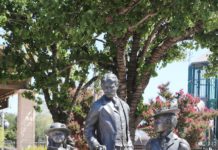Eminent domain returned, yet again, to the last Morgan Hill
School Board meeting of 2002, this time over the district
’s need to improve access to the Sobrato High School campus,
under construction off Burnett Avenue, east of Monterey Road.
Eminent domain returned, yet again, to the last Morgan Hill School Board meeting of 2002, this time over the district’s need to improve access to the Sobrato High School campus, under construction off Burnett Avenue, east of Monterey Road.
Eminent domain is a legal procedure whereby a government agency can acquire private property for the “greater public good,” in this case to build a public high school. Under eminent domain, a judge or jury decides the value of the property after both sides submit appraisals.
Burnett Avenue has been deemed, by the environmental impact report, too narrow to handle 1,500 students and their cars and trucks plus curbs, gutters and bicycle lanes down both sides and residents from the two mobile home parks already in place. The road will have to be widened and the district will need additional land to do so.
No decision was reached at the meeeting. The issue is expected to reappear on the board’s Jan. 13 agenda.
Heritage trees
To accommodate the wider road, along with a boat repair building, two old oak trees on the north side of the street will have to be removed. The land, a 26-foot deep strip, with a total area of 9,621 square-feet, and the trees belong to Elaine West and her family. West spoke to the Morgan Hill School Board on Dec. 9, asking for understanding and compassion for what she and her tenants would endure during construction. She was also concerned that two fine, old trees would be lost.
Scott Plambaeck, assistant planner for the city, said if the trees are old enough to be classified heritage trees, the school district will have to follow the city’s Heritage Tree Ordinance, (Ordinance 535, chapter 12.32). The ordinance requires pulling permits and posting so the public is notified.
“If you can’t avoid the loss of a tree,” he said, “you might consider providing replacement trees, even specimen trees.”
West did not know how old the trees were but described them as probably more than 100 years old.
Of the two trees, the one nearest Monterey Road, closest to The King and I restaurant and shading its parking lot, is the largest and most substantial. At 100-years-old both would be considered Heritage Trees, Plambaeck said.
Superintendent Carolyn McKennan said she did not know about the ordinance but that the district would certainly consult the city before removing the trees.
The boat repair building is not old enough to be required to follow the city’s procedure for destroying historic structures, which the Peña family had to do recently to make space for the new Sinaloa restaurant, being rebuilt after a devastating fire in June.
Two pieces of land owned by the Reggiardo family- across Burnett Avenue from West’s property – and also considered necessary to the Burnett widening – must also be acquired by the district. A total of 9,589 square-feet, one strip is 16-feet deep, the other 26-feet deep. Offers by the district in June and October 2002 were rejected by the owners.
A resolution invoking eminent domain for the Reggiardo property was pulled from the agenda and will appear at a later, not-yet-set date.
Two other pieces of property also must be acquired by the district for the high school using eminent domain.
An 11.42-acre tract owned by Timothy Miyasaka and a 15.68-acre site at 565 Burnett Avenue owned by Haruyo Shintani compose the land on which the actual school buildings will be constructed. They are located north of Burnett Avenue, between Monterey Road and U.S. Hwy. 101, immediately south of the Sobrato site.
The district is attempting to buy the two properties for $3.5 million, the amount received from the City of San Jose for adjacent Sobrato land.
The Sobrato land was given to the MHSD by the Sobrato family as a site for the Ann Sobrato High School, the name honoring the family’s matriarch. The land, however, is in the greenbelt owned by the City of San Jose. That city refused to allow building and, after lengthy litigation, San Jose essentially gave the school district money to buy the Shintani and Miyasaka lands. The original Sobrato land will house the high school’s athletic fields, parking and some agricultural constructs.
The price will be set later this year in Santa Clara County Superior Court.
Toxic delays
During the Dec. 9 meeting, speaker Harlan Warthan brought up the matter of delays caused by toxic waste on the high school property. The construction manager, he said, should have known that any land farmed over a long period of time will retain residue from years of fertilizer, herbicide and insecticide applications.
McKennan said Thursday that the issue of a potential toxic clean up was addressed in the Environmental Impact Report.
“We hired a firm, as part of our EIR, to survey the (situation) associated with clean up activities,” she said. “Then a letter is sent to notify and survey the community.”
Because the district wants the community to feel comfortable, McKennan said, it hires an outside agency to do the survey and compile responses. Letters and survey were done by the Department of Toxic Substances Control, a division of the California Environmental Protection Agency.
McKennan also said construction cannot begin, and has not begun, on the section of the high school site under investigation until the report is complete, and the clean up work finished and approved by the state. There is yellow tape, she said, around that property now.
“We expect that in the very near future,” she said. Cost of a similar clean up at Barrett Elementary was approximately $6,000 though McKennan could not say how much a Sobrato clean up would cost.
“We don’t see this as a delay,” McKennan said about the possibility that the toxic clean up would delay the project.
One matter McKennan did say might delay construction is the board’s refusal in November to renew the contract of Jacobs, the construction management firm hired to oversee the Sobrato project.
In a limited way the construction management issue is on the agenda of a special board meeting at 6 p.m. Monday, Jan. 6: “Comparison of proposals from Turner Construction Company and Jacobs Facilities, Inc. for construction management services for Ann Sobrato High School” will be discussed as a “Presentation Discussion.”
Plans for the high school were scaled back to 173,902 square-feet to accommodate 1,500 students at an estimated cost of $76 million instead of the 2,500 originally intended. The school was originally designed at 186,000 square-feet. It will largely be funded by the $72 million bond issue, Measure B, passed in June 1999. The bond issue also included money to build Barrett Elementary and renovate the aging Live Oak High School.
Currently Sobrato High School is scheduled to open in fall 2004, two years after the official groundbreaking on Oct. 18.







